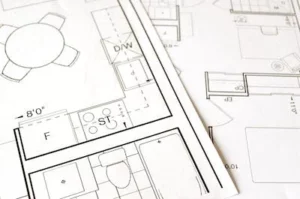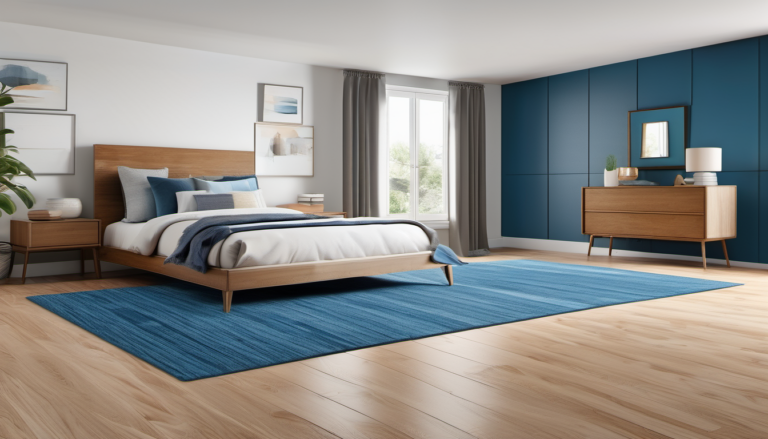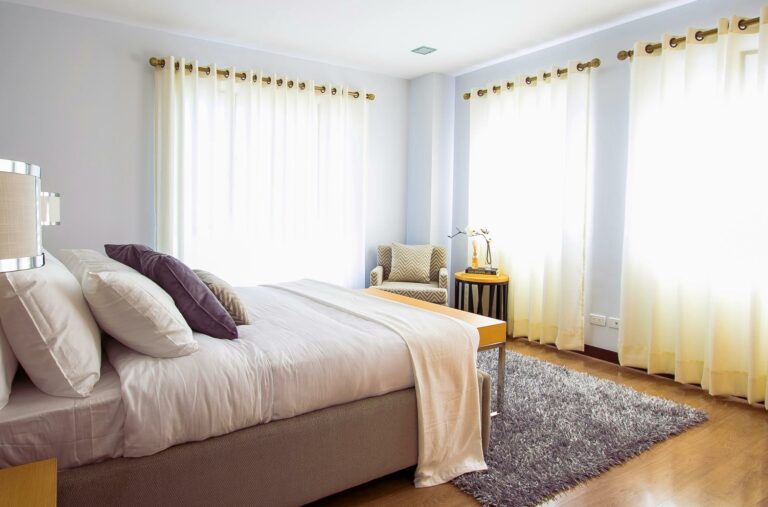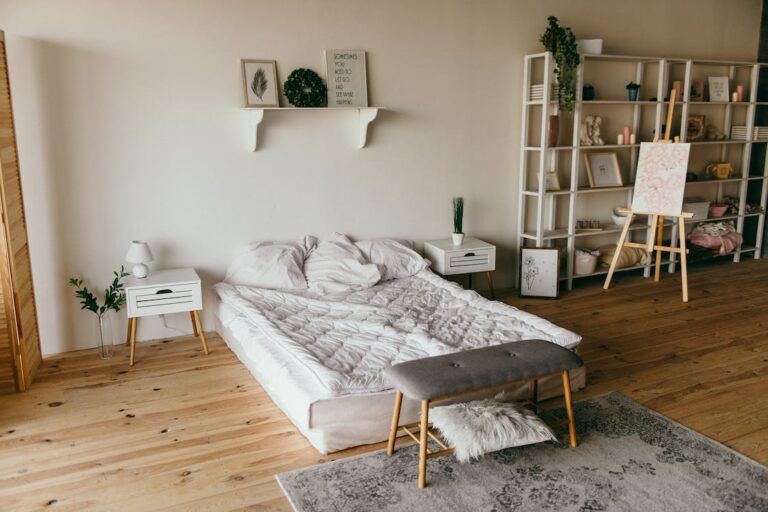Designing a Functional and Stylish Kids’ Bedroom in 2023
Designing a functional and stylish kids’ bedroom is a wonderful opportunity to create a space that reflects your child’s unique personality and provides a comfortable sanctuary for them to rest, play, and learn. Whether you are redesigning an existing bedroom or starting from scratch, careful consideration of the layout, furniture selection, colors, and overall theme can make a big difference in creating a space that your child will love.
Table of Contents
- 1 Functional and Stylish Kids’ Bedroom
- 2 Planning the Layout
- 3 Choosing the Right Furniture
- 4 Color and Theme Selection
- 5 Lighting and Window Treatments
- 6 Organizational Solutions
- 7 Accessible and Safe Design
- 8 Personalization and Decor
- 9 Creating a Playful Learning Environment
- 10 Conclusion
- 11 Frequently Asked Questions
Functional and Stylish Kids’ Bedroom

A well-designed kids’ bedroom not only needs to be visually appealing, but it should also be practical and functional. As parents, it is important to strike a balance between creating a space that sparks imagination and creativity and one that serves the practical needs of your child. With some thoughtful planning and creative ideas, you can design a room that meets both criteria.
In this article, we will explore different aspects of designing a functional and stylish kids’ bedroom, from planning the layout and choosing the right furniture to selecting colors and themes, as well as organizing the space for optimum functionality and safety. We will also discuss ways to personalize the room and create a playful learning environment that encourages growth and development.
So, let’s dive in and discover how you can create a dream bedroom for your little one that combines functionality and style!
“A child’s bedroom is a space where dreams can come true and imaginations can soar. It is a place for them to feel safe, comfortable, and inspired.”
Planning the Layout

When designing a kids’ bedroom, the layout plays a crucial role in maximizing the functionality of the space and creating a comfortable environment for your little ones. Here are some key considerations to keep in mind when planning the layout of a kids’ bedroom:
Determining the Space Available
Before you start envisioning the layout, take the time to measure the dimensions of the room. Understanding the available space will help you make informed decisions about furniture placement and the overall design of the room. Consider the following:
- Room size: Is the room spacious enough to accommodate all the essential furniture pieces, as well as additional features like play areas or study corners?
- Ceiling height: If the ceiling is low, it’s important to choose furniture and decorations that won’t make the room feel cramped or overcrowded.
- Windows and doors: Take note of the location and size of windows and doors, as they can impact the placement of furniture and the flow of the room.
Creating Zones for Different Activities
To make the most of the space, it’s a good idea to create designated zones within the bedroom for different activities. This helps children understand the purpose of each area and promotes organization. Here are a few ideas for different zones:
- Sleeping zone: This is where the bed(s) should be placed, ensuring it’s easily accessible for both children and parents during bedtime routines.
- Play zone: Dedicate a specific area for play, where children can have fun and let their imaginations run wild. This can include a play mat, toy storage, and a small table for activities.
- Study zone: If your child is of school age, it’s important to provide them with a quiet space for studying and doing homework. Include a desk or study area with proper lighting and storage for books and supplies.
- Storage zone: Incorporate ample storage options for toys, books, and clothes to keep the room organized and clutter-free. Utilize bins, shelves, and wardrobes to make the most of the available space.
By carefully planning the layout and creating distinct zones, you can design a kids’ bedroom that is both functional and aesthetically pleasing. The next step is to choose the right furniture to complement the layout.
Choosing the Right Furniture

When it comes to designing a functional and stylish kids’ bedroom, choosing the right furniture is essential. Furniture not only serves a practical purpose but also adds to the overall aesthetics of the space. Here are a few key considerations when selecting furniture for your kids’ bedroom:
Bed Selection
A comfortable and age-appropriate bed is the foundation of any kids’ bedroom. Consider the following factors when choosing a bed:
- Size: Opt for a bed that is appropriate for your child’s age and size. While a crib or toddler bed may be suitable for younger children, older kids may need a twin or full-sized bed.
- Safety: Look for beds with safety features such as guardrails for younger children or low-height designs to prevent falls.
- Storage: Consider beds with built-in storage options such as drawers or shelves, which can help maximize space in a smaller bedroom.
Storage Solutions
Kids have a lot of stuff, from toys and books to clothes and school supplies. Adequate storage solutions are essential to keep their room neat and organized. Here are a few ideas for storage furniture:
- Chests or Dressers: Invest in a sturdy chest or dresser that provides ample space for clothing and accessories.
- Bookshelves: Bookshelves not only keep books organized but also add a decorative touch to the room. Look for adjustable shelves to accommodate growing book collections.
- Cube Shelving Units: Cube shelving units are versatile and can be used to store toys, games, or other small items. Add colorful bins or baskets to keep everything tidy.
Desk and Study Area
Creating a dedicated desk and study area is important to encourage learning and productivity. Consider the following when choosing furniture for this space:
- Desk: Look for a sturdy desk with enough surface area for writing, drawing, and using a laptop or computer. Adjustable-height desks are a great option as they can grow with your child.
- Chair: Choose an ergonomically designed chair that provides proper support and comfort during study sessions.
- Storage: A desk with built-in storage compartments or drawers can help keep school supplies organized and easily accessible.
Remember to involve your child in the furniture selection process. Let them choose colors or themes that reflect their personality and interests. After all, their room should be a reflection of their individuality.
Color and Theme Selection

Choosing the right color scheme and theme for your kids’ bedroom is an important step in creating a functional and stylish space. The colors and theme you choose can set the tone for the room, creating a fun and engaging environment that reflects your child’s personality. Here are some tips to help you make the right color and theme selections:
Engaging and Fun Colors
When it comes to kids’ bedrooms, you want to choose colors that are vibrant and stimulating. Bright colors can help energize the room and create a playful atmosphere. Consider incorporating colors like:
- Bold primary colors: Red, blue, and yellow can add a pop of excitement to the room.
- Soft pastels: Light pastel shades can create a soothing and calming effect.
- Neutral colors: Neutral colors like gray or beige can serve as a great base for the room and allow you to introduce pops of color through accessories and artwork.
Theme Options
Choosing a theme for your child’s bedroom can add a touch of magic and make the room feel like a personal sanctuary. Here are some popular theme options to consider:
- Sports theme: If your child loves sports, you can incorporate their favorite sports team colors or sports-related decor.
- Princess or fairy tale theme: Create a dreamy and whimsical space with a princess or fairy tale theme, complete with a canopy bed and magical decor.
- Outer space theme: Fuel your child’s imagination with an outer space theme, featuring planets, stars, and rockets.
- Animal theme: Bring the wild into the room with an animal-themed decor, incorporating elements like wall decals, stuffed animals, and animal-print fabrics.
Remember to involve your child in the selection process and let them choose the theme and colors that they love. This will help create a sense of ownership and make their room a place they truly enjoy spending time in.
Pro Tip: You can also use removable wall decals or wallpaper to easily change the theme or colors as your child grows and their interests change.
By carefully selecting colors and themes that resonate with your child’s interests and personality, you can create a kid’s bedroom that not only looks great but also inspires creativity and imagination. So have fun exploring different color combinations and themes, and let your child’s room become a space that reflects their unique spirit.
Lighting and Window Treatments

When designing a kids’ bedroom, one important aspect to consider is lighting and window treatments. The right lighting and window treatments can enhance the overall atmosphere of the room and create a cozy and comfortable space for your child. Here are some tips and ideas to help you make the right choices:
Optimizing Natural Light
- Natural light is essential for any room, especially a kids’ bedroom. It not only brightens up the space but also has numerous health benefits.
- Position the bed and study area near windows to maximize natural light exposure during the day.
- Consider installing sheer curtains or blinds that allow the light to filter in while providing privacy.
- If privacy is not a concern, opt for no window treatments to let in as much natural light as possible.
Accent Lighting
- Besides natural light, accent lighting plays a crucial role in creating a warm and inviting atmosphere in a kids’ bedroom.
- Install a ceiling light fixture with a dimmer switch. This will allow you to adjust the lighting according to different activities or moods.
- Add bedside lamps for nighttime reading or a soft nightlight for a calming effect when it’s time to sleep.
- Consider installing LED strip lights under shelves, behind headboards, or along the floor to create a magical ambiance.
Window Treatment Options
Window treatments not only add style but also control the amount of light that enters the room. Here are some options to consider:
| Type of Window Treatment | Benefits |
|---|---|
| Curtains |
|
| Blinds |
|
| Roller Shades |
|
| Shutters |
|
Choose window treatments that are child-friendly, such as cordless blinds or curtains with tiebacks, to ensure the safety of your little ones.
Remember, the key to lighting and window treatments in a kids’ bedroom is to create a balance between functionality and aesthetics. By incorporating natural light, accent lighting, and selecting the right window treatments, you can create a cozy and inviting space that your child will love spending time in.
Organizational Solutions

When designing a kids’ bedroom, it’s essential to create a space that not only looks great but also functions well for your child’s needs. Organizational solutions play a vital role in keeping the room neat, tidy, and clutter-free. Here are some tips to help you incorporate effective organizational solutions in your child’s bedroom:
Toy and Book Storage
- Create designated storage areas: Assign specific spots for toys and books to ensure they have a proper place to be stored when not in use. This helps teach your child the importance of organization.
- Invest in functional storage units: Consider investing in shelves, bookcases, or storage bins that are easy for your child to access and use. Opt for options with colorful bins or labels to make it more engaging for them.
- Rotate toys: If your child has an extensive toy collection, it’s a good idea to rotate them periodically. This keeps their bedroom from feeling cluttered and also makes old toys feel new and exciting again.
Clothing Storage
- Use a combination of solutions: Incorporate a mix of drawers, shelves, and hanging space to store your child’s clothes. This helps them easily find and put away their clothing items.
- Optimize closet space: Make the most of the closet space by installing additional storage organizers such as hanging rods, cubbies, or shoe racks. This helps maximize the storage capacity and keeps everything in its place.
- Label drawers or bins: Attach labels to drawers or bins to indicate what type of clothing should be stored in each. This makes it easier for your child to maintain an organized wardrobe.
Display and Showcase Areas
- Create a gallery wall: Display your child’s artwork or favorite photos by creating a gallery wall. This not only adds a personal touch to the room but also keeps their creations in view for everyone to admire.
- Install shelves for trophies or special items: If your child has trophies, certificates, or other special items they’d like to showcase, install shelves or a display case for them. This allows them to proudly display their achievements.
- Utilize a bulletin board or corkboard: Attach a bulletin board or corkboard to the wall to showcase important notes, to-do lists, or reminders. It’s a great way for your child to keep track of their schedule and stay organized.
Remember, incorporating organizational solutions in your child’s bedroom is not only practical but also teaches them valuable skills in tidiness and organization. By creating storage spaces for their toys, books, clothes, and personal items, you are fostering a sense of responsibility and independence in your child.
“A well-organized room makes it easier for kids to take responsibility for their belongings and maintain cleanliness.”
Accessible and Safe Design

When designing a kids’ bedroom, it’s essential to prioritize safety and accessibility. Here are some key considerations to ensure that your child’s room is a safe and welcoming space:
Childproofing Measures
- Childproofing is crucial to prevent accidents and injuries. Install safety locks on drawers and cabinets to keep hazardous items out of reach.
- Secure heavy furniture, such as dressers and bookshelves, to the wall to prevent tipping.
- Use outlet covers and cord organizers to keep electrical items and wires safely out of sight and reach.
- Consider softening sharp corners on furniture or install edge protectors to minimize the risk of injury.
Easy Accessibility
- Optimize the layout of the room to make it easy for children to navigate independently. Keep essentials within their reach, like clothes, toys, and books, so they can access them without assistance.
- Use kid-friendly storage solutions like low shelves, labeled bins or baskets, and open cubbies to encourage tidiness and give your child independence in maintaining a clean and organized space.
- Choose furniture that is appropriately sized for your child’s height. Lower beds, accessible desks, and chairs designed for children will ensure comfort and ease of use.
“Designing a safe and accessible bedroom for your child is crucial to create a secure and enjoyable environment.”
Remember, your child’s safety should always be the top priority when designing their bedroom. By implementing childproofing measures and ensuring easy accessibility, you can create a space that promotes your child’s independence and reduces potential hazards.
Image source: Unsplash.com
In our next section, we will explore how to infuse your child’s bedroom with personalization and decor that reflects their personality and style.
Personalization and Decor

When it comes to designing a functional and stylish kids’ bedroom, personalization and decor are key elements that can really bring the space to life. The right decor can create a warm and inviting atmosphere, while also reflecting your child’s unique personality and interests. Here are some tips to help you add those personal touches to your child’s bedroom:
Wall Decor and Artwork
Adding wall decor and artwork is a great way to jazz up any space, and your child’s bedroom is no exception. Here are a few ideas:
– Wall decals: These are a fun and easy way to add some color and personality to the walls. They come in a variety of designs, from animals and nature scenes to superheroes and princesses.
– Posters and prints: Choose some posters or prints that showcase your child’s favorite hobbies or interests. Whether it’s their favorite sports team, a beloved cartoon character, or a quote that inspires them, these can really make the room feel personalized.
– Gallery wall: Consider creating a gallery wall using a mix of framed artwork, family photos, and other mementos. This allows for a mix of personalization and decor, while also showcasing your child’s favorite memories and achievements.
Bedding and Linens
The bedding and linens you choose for your child’s bedroom can make a big impact on the overall look and feel of the space. Here are a few things to consider:
– Color scheme: Choose colors that go well with the rest of the room’s decor. Opt for vibrant and playful hues to create a fun and inviting atmosphere.
– Comfort and quality: Invest in good-quality bedding and linens that are both comfortable and durable. Look for materials that are soft, hypoallergenic, and easy to clean.
– Pattern and design: Consider bedding with patterns or designs that reflect your child’s interests. Whether it’s dinosaurs, unicorns, or outer space, these can add a touch of whimsy to the room.
Personal Touches
Don’t forget to include those special personal touches that truly make the room feel like your child’s own. Here are a few ideas:
– Name letters: Hang wooden or fabric letters spelling out your child’s name on the wall. This not only adds a personal touch, but it also helps with learning letters and spelling.
– Memory board: Create a memory board where your child can display photos, artwork, and other special mementos. This allows them to showcase their favorite memories and achievements.
– Favorite toys or collections: If your child has a favorite toy or collection, find a way to display it in their room. This not only adds a personal touch, but it also keeps their cherished items within reach.
Remember, the key to personalization and decor is to create a space that reflects your child’s interests and personality. Get them involved in the design process and let their imagination run wild. With a little creativity and personal touch, you can create a bedroom that your child will love and cherish for years to come.
Creating a Playful Learning Environment

When it comes to designing a kids’ bedroom, creating a playful learning environment is key. This is the space where your child will not only sleep but also play, learn, and grow. By incorporating educational elements into the room, you can encourage creativity, curiosity, and a love for learning. Here are some tips for creating a playful learning environment in your child’s bedroom:
Incorporating Educational Toys
To make learning fun, it’s important to have plenty of educational toys in your child’s bedroom. These toys can stimulate their imagination, encourage problem-solving skills, and promote educational development. Consider toys such as building blocks, puzzles, science kits, and interactive learning games. These types of toys not only entertain your child but also engage their mind and promote cognitive development.
Setting Up a Study Corner
Creating a dedicated study corner in your child’s bedroom can help foster a love for learning and provide them with a quiet and organized space to do their homework. Here are some ideas for setting up a study corner:
- Desk and Chair: Invest in a sturdy desk and a comfortable chair that is suitable for your child’s age and size.
- Organizational Tools: Provide storage solutions such as shelves, drawers, and bins to keep school supplies organized.
- Good Lighting: Ensure that the study corner has adequate lighting, both natural and artificial, to prevent eye strain and promote focus.
- Inspiring Decor: Hang a corkboard or a whiteboard on the wall to display important reminders, schedules, and inspirational quotes.
By creating a well-designed study corner, you can create a space where your child will feel motivated and inspired to learn.
Remember, it’s important to strike a balance between play and study. A playful learning environment should encourage exploration, creativity, and critical thinking while allowing your child to have fun and enjoy their time in their bedroom.
Also read; Small Bathroom, Big Style: Design Ideas for Limited Spaces in 2023
Conclusion
Designing a functional and stylish kids’ bedroom requires careful planning and attention to detail. By considering the layout, furniture choices, color and theme selection, lighting and window treatments, organizational solutions, accessible and safe design, personalization and decor, and creating a playful learning environment, you can create a space that is both practical and enjoyable for your child.
Remember, a well-designed kids’ bedroom should provide a balance between functionality and aesthetics. It should be a space where your child feels comfortable, safe, and inspired. By incorporating their interests and personality, you can create a room that reflects their individuality and fosters their creativity and growth.
Here are some key takeaways to keep in mind when designing your child’s bedroom:
- Plan the layout: Determine the available space and create zones for different activities like sleeping, studying, playing, and storage.
- Choose the right furniture: Select a suitable bed, storage solutions, and a desk or study area that caters to your child’s needs and preferences.
- Consider color and theme selection: Opt for engaging and fun colors that stimulate your child’s imagination, and choose a theme that reflects their interests.
- Pay attention to lighting and window treatments: Maximize natural light, incorporate accent lighting, and select appropriate window treatments that provide privacy and control light levels.
- Implement organizational solutions: Include toy and book storage, clothing storage, and display areas to keep the room tidy and organized.
- Ensure accessibility and safety: Install childproofing measures and make sure the room has easy accessibility for your child.
- Add personalization and decor: Incorporate wall decor and artwork, choose bedding and linens that match the theme, and include personal touches that make the room feel special.
- Create a playful learning environment: Incorporate educational toys and set up a dedicated study corner to promote learning and creativity.
By following these guidelines and incorporating your child’s input, you can create a functional and stylish kids’ bedroom that they will love spending time in. Remember to consider their needs, interests, and personal style, and make the space a reflection of who they are. With a little planning and creativity, you can create a room that both you and your child will be proud of. Happy designing!
Frequently Asked Questions
- What are some key design elements to consider when designing a kids’ bedroom?Some key design elements to consider when designing a kids’ bedroom are age-appropriate furniture, ample storage solutions, a playful color palette, durable materials, and safety features.
- How can I create a functional and stylish kids’ bedroom on a budget?To create a functional and stylish kids’ bedroom on a budget, consider repurposing furniture, DIY projects, utilizing storage cubes or bins, opting for affordable wall decals, and shopping for secondhand or discounted items.
- What are some popular themes for kids’ bedrooms?Some popular themes for kids’ bedrooms include ocean or beach theme, outer space theme, princess or fairy tale theme, superhero theme, and sports theme. Choose a theme that reflects your child’s interests and personality.
- How can I maximize storage in a small kids’ bedroom?To maximize storage in a small kids’ bedroom, consider using multi-functional furniture like beds with built-in drawers, utilizing vertical space with wall shelves or hanging organizers, and using under-bed storage containers.
- What lighting options are suitable for a kids’ bedroom?Suitable lighting options for a kids’ bedroom include a combination of ambient lighting, task lighting, and nightlights. Use ceiling or pendant lights, bedside lamps, and dimmable lights to create a cozy and functional atmosphere.







